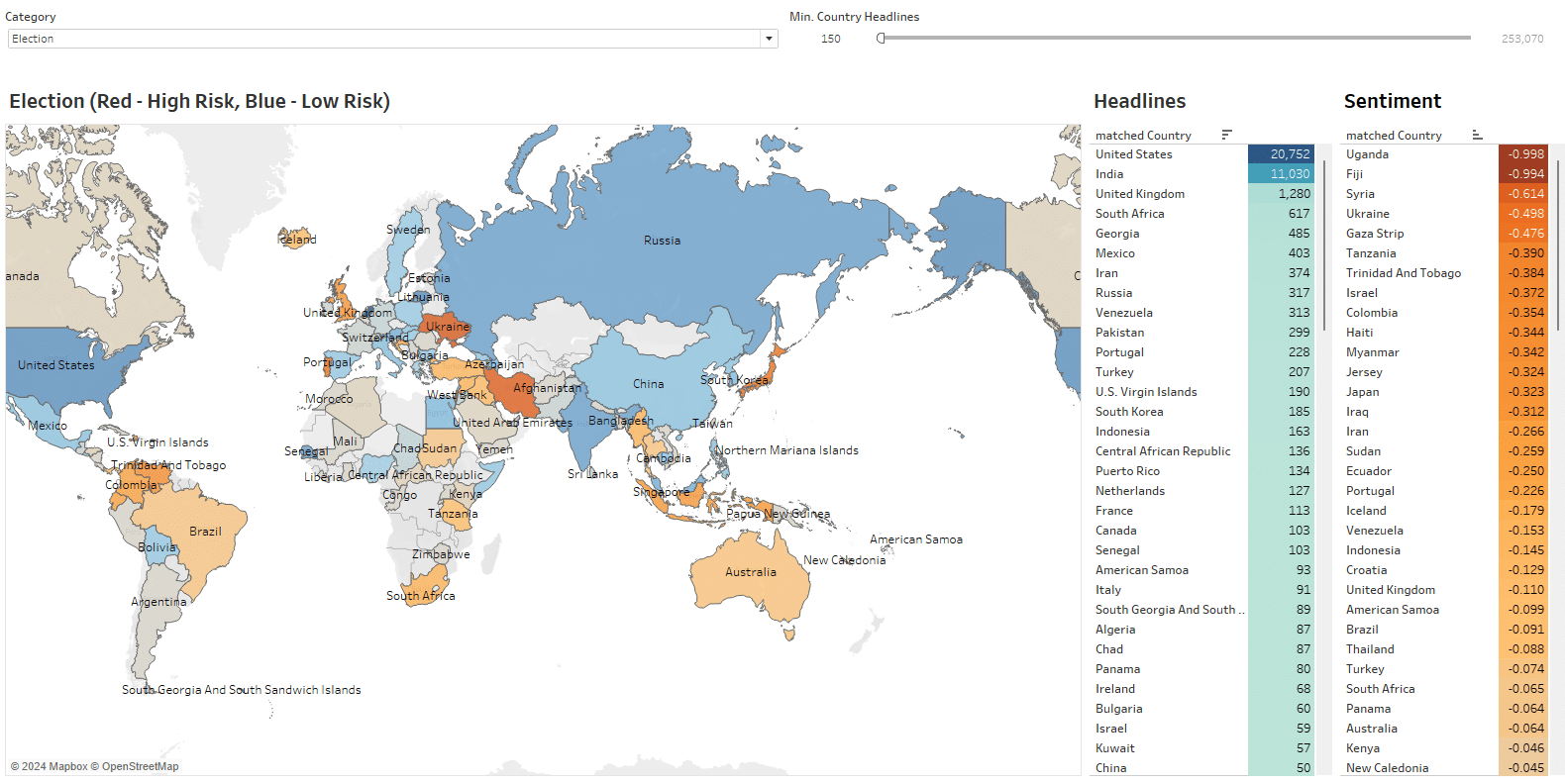Recent geopolitical data from our news sentiment analysis sheds light on the global landscape of election-related risks and media coverage. Our data provides a look at regions of concern and stability, with significant variations in election risks apparent across countries. This is all underpinned by our innovative technology which facilitates extensive media coverage and sentiment analysis.
Mapping global election risks 2024
First, let’s take a look at the world map above visualizing countries based on their election risk levels. How do we interpret this data? The risk levels are indicated by colour codes: so red for high risk and blue for low risk.
So what did we find? Uganda, Fiji, Syria, and Ukraine are marked as red, signaling potential instability or significant issues related to the election process. Much of that is due to political unrest, allegations of election fraud, or violence related to the electoral process.
For instance, Uganda’s sentiment score is an -0.998 which shows highly critical media coverage. In Fiji, a sentiment score of -0.994 is a nod towards the tense and potentially volatile election atmosphere. The United States, India, and South Korea are marked in blue, indicating low election risk. While the United States has a high volume of election-related headlines, it doesn’t feature high on the negative sentiment list, implying a relatively balanced or even positive media tone.
Global election risks 2024: Volume of news coverage
The United States leads with 20,752 headlines, followed by India with 11,030, and the United Kingdom with 1,280. This high level of media attention indicates the significant global interest in the electoral processes of these nations on the global stage.
In obvious contrast, countries with fewer headlines, such as New Caledonia and American Samoa, indicate lower media focus. It’s important to note here that this isn’t just because of smaller electorates or less contentious political climates. It is also likely due to quieter election periods. At the end of the day, lower coverage does not necessarily correlate with the level of election risk, as some countries with lower coverage still exhibit high-risk scores.
Global elections risks sentiment analysis: A mixed bag
Now let’s take a look at the sentiment analysis. Sentiment scores range from highly negative to positive with higher negative values indicating more critical or concerning news coverage. Uganda (-0.998) and Fiji (-0.994) top the list of negative sentiment, suggesting significant issues or unrest.
It’s no surprise that Ukraine (-0.498) and Gaza Strip (-0.476) also feature prominently in the negative sentiment list. You would expect that the ongoing conflicts and political instability overshadow their electoral processes. And yet perhaps, despite high news coverage, countries like the United States and the United Kingdom do not show up in the most negative sentiment list. This indicates a relatively balanced media tone, with a mix of positive and negative coverage.
Geographical distribution of global election risks
So what does this all mean for the geographical distribution of election risks and sentiments? Quite simply, it reveals a complex global landscape. There are high-risk areas are scattered across different continents, including Africa, South America, and parts of Asia. This means election risks are not confined to a particular region but are a global concern. The crisis in Uganda and Tanzania reflects political tensions and electoral challenges in Africa. Meanwhile, South America, Brazil and Colombia are marked as high-risk areas, indicating potential instability in their electoral processes. As for low-risk areas, these are primarily found in North America, parts of Europe, and select countries in Asia. These regions, including the United States, United Kingdom, and South Korea, exhibit relatively stable electoral processes of course.
Global elections risks: Implications for stakeholders
As we’ve discussed in previous articles, understanding election risks and sentiments is a non-negotiable for a number of stakeholders, including policymakers, investors, and journalists. For policymakers, identifying high-risk areas can help in allocating resources to ensure fair and safe elections. This is where the importance of international monitoring, support for democratic institutions, and conflict prevention initiatives comes in.
For investors and businesses, we know that insights into election risks are essential for strategic decision-making. Of course, there’s a reason why high-risk elections can lead to political instability, affecting market conditions and investment climates. But by understanding the risk landscape, investors can make informed decisions about where to focus or avoid during election periods. This method applies to both local and international investments. Another interesting use case here is journalists and analysts. Using sentiment analysis to gauge public perception and media tone can be a secret weapon in reporting and strategic planning in a fiercely competitive landscape where share of readership is hotly fought for.
It’s easier than ever to get a comprehensive view of global election risks and sentiments with our AI-driven news sentiment analysis. By mapping risk levels and analyzing media coverage, we can easily identify areas of concern and stability. The potential for this for stakeholders seeking to navigate the complex landscape of global elections more effectively is huge.
